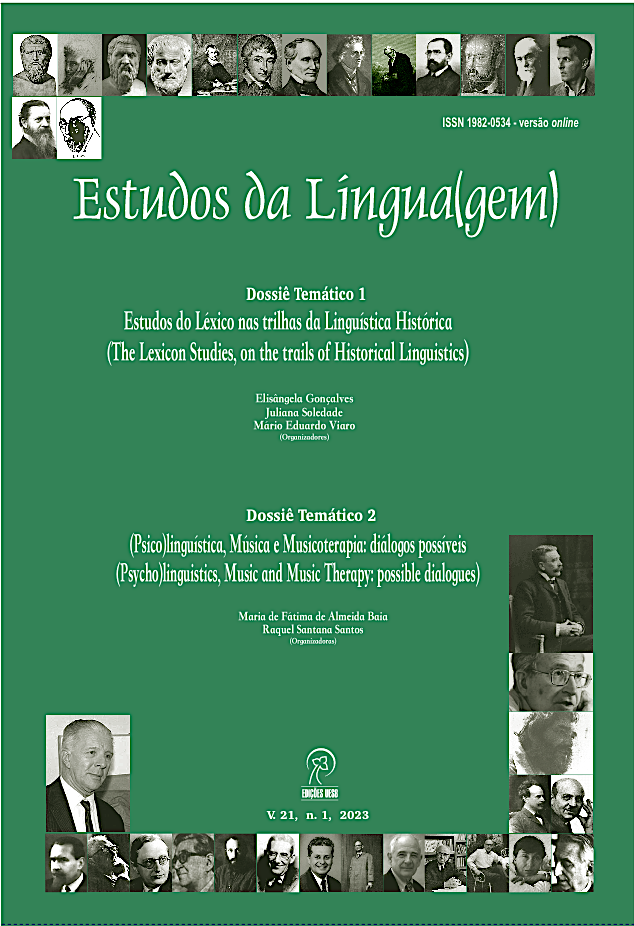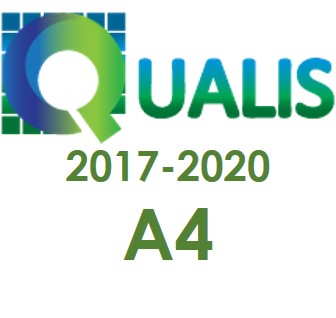Music and Intonation in Portuguese
DOI:
https://doi.org/10.22481/el.v21i1.13364Keywords:
Music; Intonation; Language; Speech.Abstract
In this essay, we aim to establish a relationship between the musical melodic formation and the production of speech intonation, especially considering the historical development of some aspects of western music. For this, it was necessary to understand the modal diversity regarding the melodic formations, but, mainly, the establishment of melodies in which the final tone characterizes the creation of a unity of meaning. For speech intonation, formal descriptions and interpretations of phrasal endings between different linguistic productions were sought. Starting from the parallelism of such changes and descriptions in the intonation of speech and music, it is intended to demonstrate that this hypothesis of joint variation between music and speech explains both the almost universal acceptance of tonal music based on the tempered scale and the establishment of intonation marks. standardized through schooling.
Downloads
References
ARISTÓTELES. Arte retórica e arte poética. Trad. do Francês por Antônio Pinto de Carvalho. Rio de Janeiro: Ediouro, s.d. p. 173
BERTON, C. G. Inventividade melódica: uma outra abordagem das técnicas de análise, composição e improvisação em música popular. Orientador: CARRASCO, C. 2005. 198 f. (Mestrado) - Música, Unicamp, Campinas
CAGLIARI, L. C. O sistema entoacional do português brasileiro. In: CAGLIARI, L. C. Elementos de fonética do português brasileiro. São Paulo: Editora Paulistana, 2007.
CARRINGTON, J. F. The talking drums of Africa. Scientific American, v. 225, n. 6, p. 90-95, 1971.
COMPÖTE, E. D. L. Teoria e prática musical. Porto Alegre: Escola Superior de Teologia São Lourenço de Brindes; Sociedade Literária São Boaventura; Universidade de Caxias do Sul, 1977.
DEUSEN, Nancy van. The Cultural Context of Medieval Music. Santa Barbara: Praeger, 2011.
ESCOFFIER N, ZHONG J, SCHIRMER A, QIU A. Emotional expressions in voice and music: same code, same effect? Human Brain Mapping, v. 34, n. 8, p. 1796-810, 2013.
FALÉ, I.; FARIA, I.H. Percepção Categorial de contrastes entoacionais em Português Europeu. Actas do XXI Congresso da Associação Portuguesa de Linguística, Porto, p. 341-348, 2006.
FASSLER, M. Music in Medieval West. New York; London: Norton and Company, 2014
FERREIRA NETTO, W. Introdução à fonologia da língua portuguesa. 2.ed São Paulo: Paulistana, 2011.
FERREIRA NETTO, W.; MARTINS, M. V. M.; VIEIRA, M. F. Efeitos da entoação e da duração na análise automática das manifestações emocionais. Estudos Linguísticos, v. 43, n. 1, p. 22-32, 2014. p. 26
FERREIRA NETTO, W. Fonologia, discurso e interdisciplinaridade: relações possíveis entre a fonologia e a música. Hipátia - Revista Brasileira de História, Educação e Matemática, v. 3, n. 1, 2018.
FREYTAG, G. Freytag’s Technique of the Drama. An Exposition of Dramatic Composition and Art. An authorized translation from the sixth german edition by Elias J. MacEwan, M. A. Third Edition. Chicago: Scott, Foresman and Company 1900, 1984.
GARCIA, R. R. A entoação do dialeto caipira do Médio Tietê: reconhecimento, características e formação. Tese (Doutorado em Filologia e Língua Portuguesa) — Universidade de São Paulo, 2015.
GELLNER, E. Nações e nacionalismo. Trad. Inês Vaz Pinto. Lisboa: Gradiva, 1993.
HARNONCOURT, N. O discurso dos sons. Caminhos para uma nova compreensão musical. Trad. Marcelo Fagerland. Rio de Janeiro: Jorge Zahar Editor, 1998.
KOELLREUTTER, H. J. Contraponto Modal do Século XVI (Palestrina). São Paulo: Editora Novas Metas, 1989.
KOFFKA, K. Princípios de psicologia da Gestalt. trad. de Álvaro Cabral. São Paulo: Cultrix, s.d.
MANACORDA, M. G. História da educação. Da antiguidade aos nossos dias. 3.6 ed. Trad. Gaetano Lo Monaco. São Paulo: Cortez; Autores Associados, 1992.
MATHIESEN, T. J. Apollo's Lyre. Greek music and music theory in antiquity and the middle ages. Linkoln: University of Nebraska Press, 1999.
MEDEIROS, B. R. D. Descrição comparativa de aspectos fonético-acústicos selecionados da fala e do canto em português brasileiro. Orientador: ALBANO, E. C. 2002. 166 f. (Doutor) - Linguística, Unicamp, Campinas.
MORAES, J. A. D. Intonational Phonology of Brazilian Portuguese. In: WORKSHOP ON INTONATIONAL PHONOLOGY: UNDERSTUDIED OR FIELDWORK LANGUAGES, ICPHS 2007 SATELLITE MEETING, 2007, Saarbrucken.
NATTIEZ, J.-J. Melodia. In: ROMANO, R. (Ed.). Enciclopédia Einaudi - v. 3 - Artes-Tonal/atonal. Porto: Imprensa Nacional - Casa da Moeda, 1984. p. 272-297.
PEIRCE, Ch. S. Como tornar claras as nossas ideias. In: MOTA, O. S.; HEGENBERG, L. (Eds.) Semiótica e filosofia. Texto escolhidos de Charles Sanders Peirce. São Paulo: Cultrix; Editora da Universidade de São Paulo: 1975; p. 55-56.
PEREIRA, A. R. A estética musical em Aristóxeno de Tarento. Hvmanitas, n. 47, p. 469-479, 1995.
PERETZ, I. Brain specialization for music. Neuroscientist, n. 8, v. 4, p. 374–382, 2002.
PIERREHUMBERT, J. B. The phonology and phonetics of English intonation. p. Orientador: HALLE, M. 1980. 401 f. (PhD) - Doctor of Philosophy, MIT.
PLATON. Las Leyes, o de Legislación. In: Obras Completas Trad. Maria Araújo et alii. Madrid: Aguilar, 1981. p. 1306.
RAMEU, J.-P Traité de l'harmonie. Reduite a seus principes naturels. Paris: Jean Baptiste-Christophe Ballard, 1722.
SANTOS, C. A. A. D. A. A sincronização em dois ritmos da canção: uma observação experimental acerca da fala cantada. Orientador: MEDEIROS, B. R. D. 2012. (Mestrado) - Filologia e Língua Portuguesa, Universidade de São Paulo, São Paulo.
SAUSSURE, F. de. Cours de linguistique général. Edition critique préparée par Tulio de Mauro. Paris: Payot, 1974.
SCHOENBERG, A. Harmonia. Trad. M. Maluf. São Paulo: Editora Unesp, 2001. 579 p. 85-7139-362-1.
SCHOENBERG, A. Fundamentos da composição musical. Trad. E. Seincman. São Paulo: Edusp, 2008.
SEARA, I. C.; SOSA, J. M. A identidade dialetal do “manezinho” com foco em características entonacionais. Letras de Hoje, v. 52, n. 1, p. 51-57, 2017.
SEGADO, M. et al. Partially Overlapping Brain Networks for Singing and Cello Playing. Frontiers in Neuroscience, v. 12, n. 351, p. 1-15, 2018.
SETTI, K. Os índios Guarani-Mbya do Brasil: notas sobre sua história, cultura e sistema musical. In: BISPO, A. A. Die Musikkulturen der Indianer Brasiliens. Musices Apatizo. Liber Annuarius 1994/95. Roma: Consonciatio Internationalis Musicae Sacrae, 1997. cf. também,
SKINNER, E. R. “A calibrated recording and analysis of the pitch, force and quality of vocal tones expressing happiness and sadness”. In: Speech Monographs, p. 81–137, 1935.
SPIEGEL, M. R. Estatística. Trad. C. A. Crusius. 2 ed. São Paulo: McGraw-Hill do Brasil, 1985.
SOUZA, J. A. Para uma primeira história da harmonía: das musas à música. Orientador. COSTA, A. 232 f. Dissertação. (Mestrado em Filosofia) — UFF. Niterói, 2018.
STEELE, J. Prosodia Rationalis, or An essay towards establishing the melody and measure of speech to be expressed and perpetuated by peculiar symbols. 2. ed. amended and enlarged. London: J. Nichols, 1779.
STOUT, G. Manual of Psychology. 3 ed. London: University Tutorial Press, 1921.
THALESIO, P. Arte de Canto Chão, com uma breve Instrucção, pera os Sacerdores, Diaconos, Subdiaconos, & moços do Coro, conforme o uso Romano. Coimbra: Diogo Gomez de Loureiro, 1618.
TESTA, A. Q. Caminhos de saberes guarani mbya: modos de criar, crescer e comunicar. Orientadora Dominique T. Gallois. p. 327. 2014. (Doutor) - Antropologia, USP.
TRUBETZKOY, N. S. Principios de fonología. Madrid: Cincel, 1973.
VASSOLER, A. M. O.; MARTINS, M. V. M. A entoação em falas teatrais: uma análise da raiva e da fala neutra. Estudos Linguísticos, v. 42, n. 1, p. 9-18, 2013. p. 14
WILLIAMS, C. E.; STEVENS, K. N. (1972). “Emotions and speech: Some acoustical correlates”. The Journal of the Acoustical Society of America, v. 52, n. 1, p. 1238–1250, 1972.
WISNIK, J. M. O som e o sentido. Uma outra história das músicas. São Paulo: Companhia das letras, 1989
YANO, C.; FERNANDES-SVARTMAN, F. R. Um estudo preliminar sobre a prosódia de construções com tópico e foco no português paulista. Entrepalavras, Fortaleza, v. 10, n. 1, p. 256-282, 2020.
Downloads
Published
How to Cite
Issue
Section
License

This work is licensed under a Creative Commons Attribution 4.0 International License.

Estudos da Língua(gem) is licensed under a Creative Commons Attribution 4.0 International License.
Authors who publish in the journal Estudos da Língua (gem) agree with the following terms:
The journal Estudos de Língua(gem) maintains the copyrights of the contributions published. These rights include the publication of the contribution and make its content available for free through the portal.







